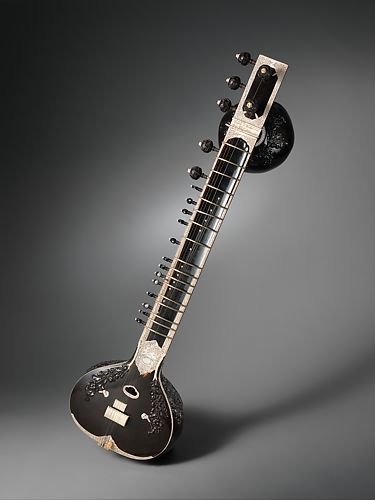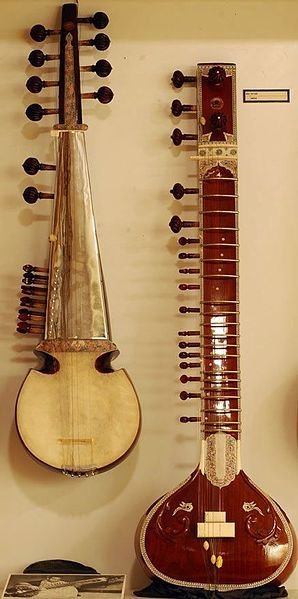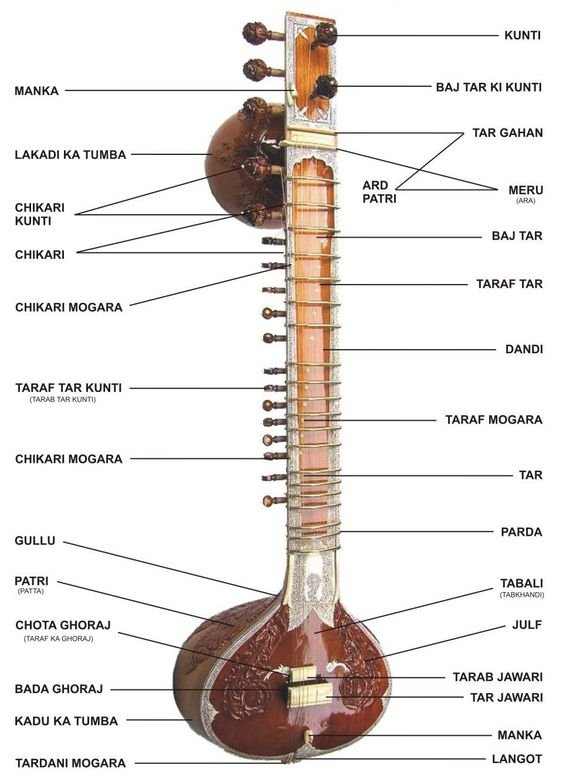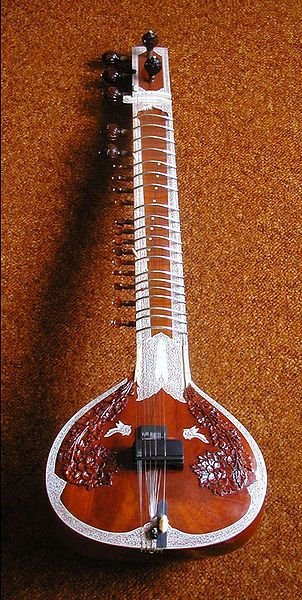“The Harmony of Strings: Exploring the World of Sitar”

INTRODUCTION
The sitar is a stringed musical instrument originating from the Indian subcontinent. Its distinctive sound and versatility have made it a popular choice for classical Indian music and fusion genres. With its intricate design and resonating strings, the sitar has captivated audiences for centuries and is an integral part of Indian culture and heritage. Join us as we delve into the world of sitar and discover the beauty and complexity of this fascinating instrument.
ORIGIN OF SITAR
The sitar originated in the Indian subcontinent, most likely in northern India, during the 16th century. It has evolved over the centuries and gained popularity in the courts of Mughal emperors. The sitar combines elements of various stringed instruments and features a long neck with 20 moveable frets and six to seven strings that are played with a wire plectrum. The sitar’s unique sound is created by the resonating sympathetic strings vibrating along with the played lines. The instrument became widely known in the Western world during the 1960s and 1970s, thanks to its use in the music of Indian classical legends such as Ravi Shankar.

The Sitar is a stringed musical instrument that originated in the Indian subcontinent. It is believed to have been created in the 16th century and has a long and rich history in Indian classical music. The word ‘Sitar’ is derived from the Persian word ‘Setar’, meaning “three strings.”
The Sitar was initially used in the court music of royalty and was also played in Hindu temples for religious purposes. It was during the Mughal rule in India that the Sitar became popular in court music and started to gain popularity among the common people. The Sitar became the dominant instrument of Indian classical music and has been used by many famous musicians, such as Ravi Shankar, Ali Akbar Khan, and Vilayat Khan.
In the 20th century, the Sitar gained popularity in the Western world through the influence of musicians such as George Harrison of the Beatles and Pandit Ravi Shankar. The Sitar has been incorporated into various genres of music, including Jazz, Rock, and World music.
Today, the Sitar continues to be an important part of Indian classical music and is still widely used by musicians around the world. The Sitar has become a symbol of Indian culture and its rich musical heritage and is considered to be one of the most beautiful instruments in the world.

HOW SITAR IS MADE
The sitar is a complex instrument that involves intricate craftsmanship to make.
- The sitar body is made from a type of gourd (often a bottle gourd) that is dried and hollowed out.
- The neck is made from either teak or tun wood and is fitted to the body with glue.
- The frets, which are made of metal wire, are tied to the neck and adjusted for proper height and spacing.
- The main playing strings are attached to the tuning pegs at the top of the neck and pass over the frets to the bridge on the body.
- The sympathetic strings, which run underneath the frets, are made of steel and are tuned to specific notes.
- The bridge is made of ivory, bone, or synthetic materials and has a curved top to allow for the proper bowing technique.
- The gourd at the base of the sitar is covered with parchment to create a soundboard.
- The sitar is finished with decorative inlaid patterns and is often painted with intricate designs.
The process of making a sitar involves a great deal of skill and precision, and it can take several weeks to several months to complete a single instrument.

SEVERAL TYPES OF SITAR
Here are a few of the most commonly known types of sitar:
- Classical Sitar – The traditional form of the sitar, used for Indian classical music.
- Esraj – A smaller sitar-like instrument with a bowed string.
- Surbahar – A bass sitar with longer strings and a deeper sound.
- Electric Sitar – A sitar modified with electric pickups and amplifiers, used in fusion and world music genres.
- Gandhar Pancham Sitar – A hybrid sitar with additional strings and sympathetic resonating strings.
- Mohan Veena – A sitar invented by Indian musician Pandit Vishwa Mohan Bhatt that features sympathetic strings, slide playing, and a more pronounced bass sound.
- Slide Sitar – A sitar that utilizes a slide mechanism to produce vibrato, similar to the Hawaiian steel guitar.

These are a few of the many variations of the sitar that have been developed over the centuries, each with its unique sound and playing style.
FEATURES OF SITAR
Here are some of the key features of a sitar:
- Neck – Long neck with 20 moveable metal frets and tuning pegs.
- Body – Hollowed-out gourd body with a soundboard covered in parchment.
- Strings – 6-7 strings, including playing and sympathetic strings, played with a wire plectrum.
- Bridge – Curved ivory or synthetic bridge that allows for proper bowing technique.
- Gourd – Resounding gourd at the base of the instrument.
- Decoration – Intricate inlaid patterns and decorative designs.
- Sympathetic strings – Steel strings that vibrate along with the played strings, adding resonance to the sound.
- Tabli – A flat piece of wood under the strings that provides a platform for the plectrum to strike the strings.
- Chikari strings – Strings that are used for rhythm accompaniment and are tuned to the same note as the main string.
These are some of the defining characteristics that set the sitar apart from other stringed instruments and contribute to its unique sound and versatility.
LIST FAMOUS MUSICIANS OF SITAR
Here is a list of some of the most renowned sitar players:
- Ravi Shankar – Considered the most famous sitar player of all time, he popularized Indian classical music in the West.
- Vilayat Khan – Considered one of the greatest sitar players of the 20th century.
- Anoushka Shankar – Daughter of Ravi Shankar, she is a highly regarded sitar player and composer.
- Nikhil Banerjee – Considered one of the greatest sitar players of the 20th century, known for his virtuosic playing style.
- Ustad Shujaat Khan – A sitar maestro known for his mastery of the instrument and innovative style.
- Pandit Buddhadev Dasgupta – An influential sitar player and teacher, known for his technical skill and musical expression.
- Imrat Khan – A sitar player and vocalist, known for his innovative style and contributions to Indian classical music.
These musicians have helped to shape the modern sitar tradition and continue to inspire new generations of musicians.

CURRENT SCENARIO
The current scenario of sitar and Indian classical music varies depending on the region, but here are a few general observations:
- Growth in popularity – In recent years, there has been a growing interest in Indian classical music and the sitar, both in India and around the world. This is due in is part to the increasing availability of recordings and live performances, as well as a growing appreciation for the unique sound and playing style of the instrument.
- New performers – There are many young musicians who are learning the sitar and continuing the tradition, bringing a fresh perspective to the instrument.
- Fusion music – The sitar is frequently used in fusion music, where it is combined with other musical styles such as jazz, rock, and electronic music to create a unique sound.
- Online learning – With the growth of the internet and online resources, it is easier for people to learn about the sitar and Indian classical music, as well as access lessons and performances.
- Cultural preservation – The sitar and Indian classical music continue to be important cultural artifacts, preserving the musical heritage of India and connecting musicians and listeners to their traditions.
Overall, the sitar and Indian classical music remain an important part of India’s cultural identity and continue to evolve and grow as a musical tradition.
CONCLUSION
In conclusion, the sitar is a versatile and complex musical instrument that has been an integral part of Indian classical music for centuries. It is known for its distinctive sound, intricate decoration, and the use of sympathetic strings to add resonance to the sound. The sitar has been popularized by legendary musicians such as Ravi Shankar and continues to be played and appreciated by musicians and listeners around the world. Despite the challenges posed by the changing musical landscape, the sitar remains an important part of India’s cultural heritage and continues to evolve as a musical tradition.



